 |
| India ink on gouache mono-print background. |
Hello! It's been a while (months!) since my last post, but I've had a good excuse: starting mid-February and finishing on Memorial Day, I went for:
 |
| Watercolor on pre-washed ink background. |
100 days of super-fun, super-disciplined, and very consistent art practice which then, well, exhausted me. Because 100 days is a lot of days. But I had fun--I did!
 |
| Watercolor and ink diptych. |
Anyone who has followed my blog or Twitter (X) account knows how much I enjoy themed challenges: NaNoWriMo, Inktober, even small 5-day personal project sprints, I have done them all. Usually these challenges have been built around an established goal such as writing 50K words in a month, or 31 days of ink drawing. The 100 Day Project was different in that it allowed room for participants to choose their own projects. For me this was the perfect time to work on the dozens of pre-painted backgrounds I had on the ready and stored away to finish "one day."
Something I do when I can't think of what to paint, or I don't feel particularly motivated, is to experiment with color. Whether I paint on individual sheets of watercolor paper or inside my sketchbook, I like to take bottled ink, watercolor, water-soluble graphite and/or watercolor crayons and just go for it, washing-in loose swaths of color, the looser the better. Not only is it restful to swish paint around without a goal in mind, but when the paint dries I then have a potential background for a more complete painting.
 |
| Watercolor on, um, watercolor! |
The only drawback to this method is the backgrounds can easily add up to an unmanageable amount. Eventually I'm faced with the day when I have to realize: "One day" is NOW.
 |
| Mixed-media using so many things I don't remember them all. |
And for the 100 Day Project, NOW brought with it much more than 100 days of using up pre-toned paper, including:
1. Just like when I first painted the backgrounds, I never really knew how I would finish each one on the different days of the challenge. I didn't know what the subject matter would be, or what colors I would use, or if the results would even be any good. In other words, I didn't have a plan other than the plan to show up every day. And that turned out to be the very best plan of all.
2. By not having a set plan I was completely open to surprise: spilled ink became rain; dark blobs became mountains; accidentally putting the wrong color on my brush became my favorite color and I couldn't imagine using anything else.
3. Having to paint something new every day forced me out of my comfort zone. To break what could have been a monotonous chore, I tried colors I tend to avoid (red in particular) or I painted on unusual paper sizes, scraps from
larger pieces that then became, for instance, a series of diptychs. An added bonus was some unexpected de-cluttering, putting those scraps to good use.
4. Adhering to a daily schedule of "paint, scan, post to social media" meant I had to work to a deadline and that meant I had to let whatever happened happen. I didn't have the luxury or time to fuss, rework, or start over. I just had to accept what was on the page and look forward to tomorrow.
5. Which also meant that some days my work was really, really bad. Again, if a piece didn't work, I had to let it go. But then I noticed something strange: no matter how bad a piece was, there was always one, if not more, parts about it I liked. Which then meant: not one minute of the challenge was a waste. Every day held valuable lessons and growth.
6. Limited time left little time to think. Often the only thing I could think of painting was trees: trees on a hill, trees by themselves, trees leading into a forest of yet more trees. At the same time, though, I was worried the repetition would be boring for my viewers. A major element of the project was the injunction that you had to post and show your work in public and I worried people would soon get sick of seeing so many trees. However, I then remembered what my wonderful art teacher, the late Gary Sanchez always said: "Don't just paint a sunflower. Paint a hundred
sunflowers. A thousand sunflowers! Become a sunflower expert!" I still might not be an expert, having at least 876 more trees to go to reach one thousand, but I'm on the way!
7. Expert or not, the thought of showing my work every day was scary. I soon discovered there was absolutely nothing to be afraid of. The people who saw my work were so kind, supportive, complimentary, funny, and appreciative of my efforts and willingness to tackle the project that this alone made every minute worth it. I am so grateful for their encouragement as well as the many times they let me know how inspired they had become to embark upon their own creative paths. It was beyond amazing to think my little trees were actually making a difference to people. Because at the end of the day, isn't that what the arts are about: making a difference?
 |
| Water-soluble graphite, ink, and watercolor crayons. |
Now that the project is over and I've sorted through my sketchbooks and papers and cleared my work space in preparation for the next challenge (!) and finally written this post, I've matted and readied a few of my favorite 100-Day pieces for sale. You can find them on my website under "Artwork." Enjoy and thanks for visiting!
Tip of the Day: The best challenges are never about the finished work. Instead, regard of them as a framework to use as a focusing tool, asking yourself:
- What would I like to learn from a challenge? A new skill; an improved skill; how to use my materials; or simply a chance meet other creatives?
- What can I give up in my daily schedule to make time for a challenge? What activity isn't serving me as much as taking time for my creative work could do?
- What is the one thing I've wanted to try but never have--could I do it now, or is there a later date I can set aside this year and give it my full attention?









